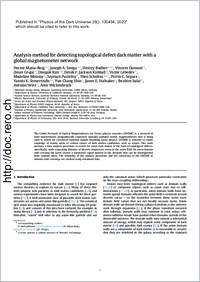Analysis method for detecting topological defect dark matter with a global magnetometer network
- Masia-Roig, Hector Helmholtz Institut Mainz, Johannes Gutenberg-Universität, 55099 Mainz, Germany
- Smiga, Joseph A. Helmholtz Institut Mainz, Johannes Gutenberg-Universität, 55099 Mainz, Germany
- Budker, Dmitry Helmholtz Institut Mainz, Johannes Gutenberg-Universität, 55099 Mainz, Germany - Department of Physics, University of California, Berkeley, CA 94720-7300, USA - Nuclear Science Division, Lawrence Berkeley National Laboratory, Berkeley, CA 94720, USA
- Dumont, Vincent Department of Physics, University of California, Berkeley, CA 94720-7300, USA
- Gruji, Zoran Nuclear Science Division, Lawrence Berkeley National Laboratory, Berkeley, CA 94720, USA - Physics Department, University of Fribourg, Chemin du Musée 3, CH 1700 Fribourg, Switzerland
- Kim, Dongok Center for Axion and Precision Physics Research, IBS, Daejeon 34051, Republic of Korea - Department of Physics, KAIST, Daejeon 34141, Republic of Korea
- Kimball, Derek F. Jackson Department of Physics, California State University — East Bay, Hayward, CA 94542-3084, USA
- Lebedev, Victor Physics Department, University of Fribourg, Chemin du Musée 3, CH 1700 Fribourg, Switzerland
- Monroy, Madeline Department of Physics, California State University — East Bay, Hayward, CA 94542-3084, USA
- Pustelny, Szymon Institute of Physics, Jagiellonian University, prof. Stanislawa Lojasiewicza 11, 30-348, Kraków, Poland
- Scholtes, Theo Physics Department, University of Fribourg, Chemin du Musée 3, CH 1700 Fribourg, Switzerland - Leibniz Institute of Photonic Technology, Albert-Einstein-Straße 9, D-07745 Jena, Germany
- Segura, Perrin C. Department of Physics and Astronomy, Oberlin College, Oberlin, OH 44074, USA
- Semertzidi, Yannis K. Center for Axion and Precision Physics Research, IBS, Daejeon 34051, Republic of Korea - Department of Physics, KAIST, Daejeon 34141, Republic of Korea
- Shin, Yun Chang Center for Axion and Precision Physics Research, IBS, Daejeon 34051, Republic of Korea
- Stalnaker, Jason E. Department of Physics and Astronomy, Oberlin College, Oberlin, OH 44074, USA
- Sulai, Ibrahim Department of Physics & Astronomy, One Dent Drive, Bucknell University, Lewisburg, PA 17837, USA
- Weis, Antoine Physics Department, University of Fribourg, Chemin du Musée 3, CH 1700 Fribourg, Switzerland
- Wickenbrock, Arne Helmholtz Institut Mainz, Johannes Gutenberg-Universität, 55099 Mainz, Germany
-
01.05.2020
Published in:
- Physics of the Dark Universe. - 2020, vol. 28, p. 100494
English
The Global Network of Optical Magnetometers for Exotic physics searches (GNOME) is a network of time-synchronized, geographically separated, optically pumped atomic magnetometers that is being used to search for correlated transient signals heralding exotic physics. GNOME is sensitive to exotic couplings of atomic spins to certain classes of dark matter candidates, such as axions. This work presents a data analysis procedure to search for axion dark matter in the form of topological defects: specifically, walls separating domains of discrete degenerate vacua in the axion field. An axion domain wall crossing the Earth creates a distinctive signal pattern in the network that can be distinguished from random noise. The reliability of the analysis procedure and the sensitivity of the GNOME to domain-wall crossings are studied using simulated data.
- Faculty
- Faculté des sciences et de médecine
- Department
- Département de Physique
- Language
-
- English
- Classification
- Physics
- License
-
License undefined
- Identifiers
-
- RERO DOC 328666
- DOI 10.1016/j.dark.2020.100494
- Persistent URL
- https://folia.unifr.ch/unifr/documents/308778
Statistics
Document views: 158
File downloads:
- pdf: 239
